|
|
| |
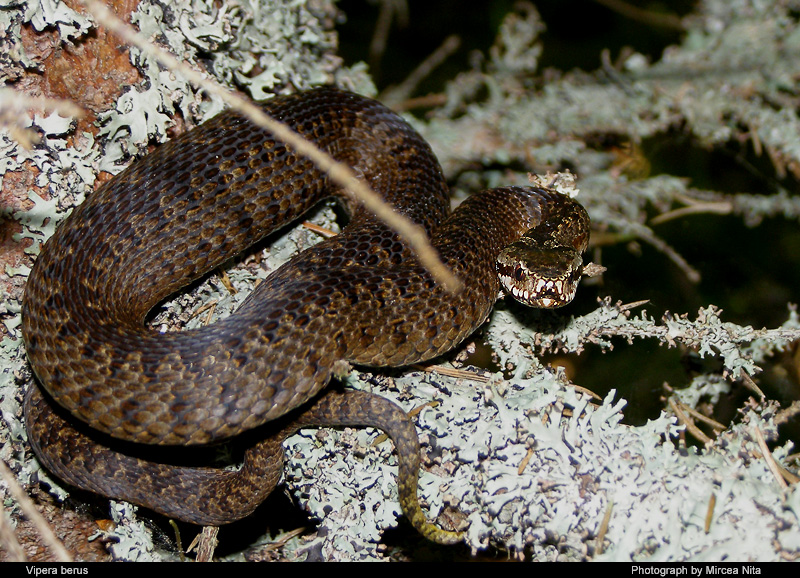
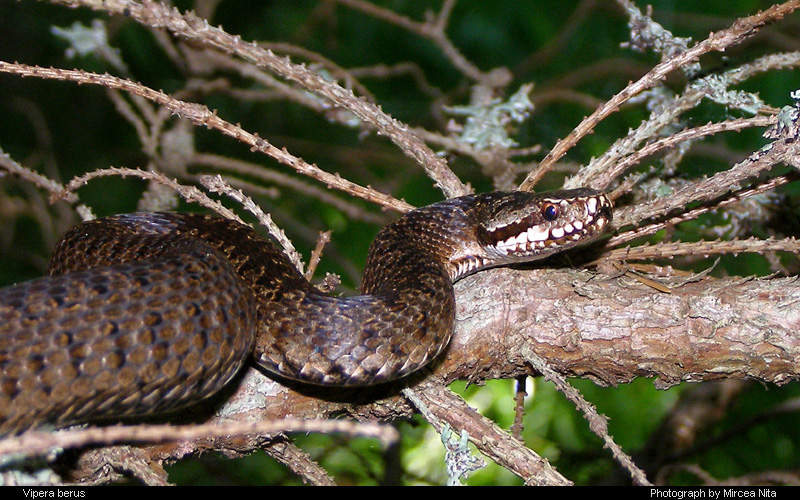
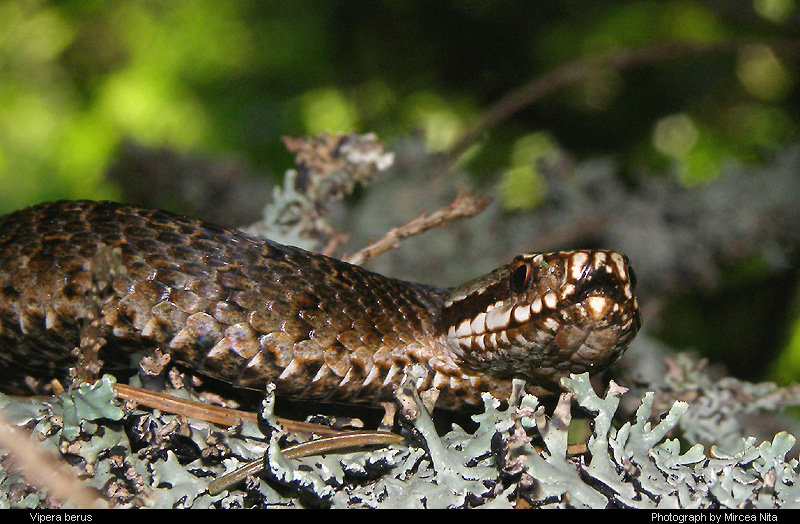
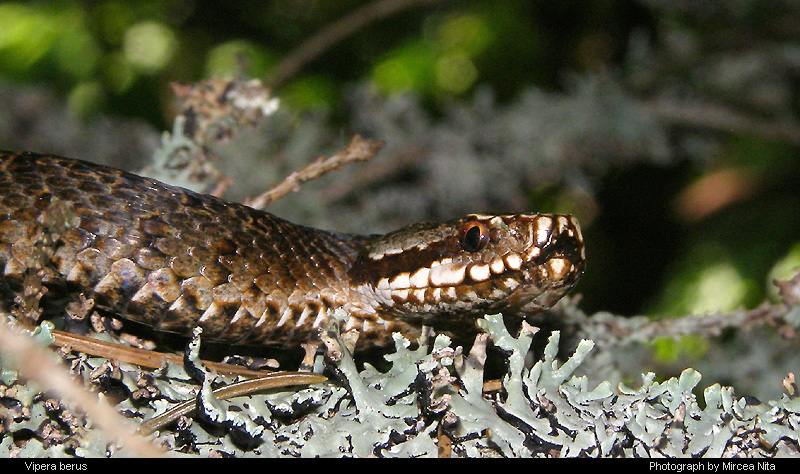
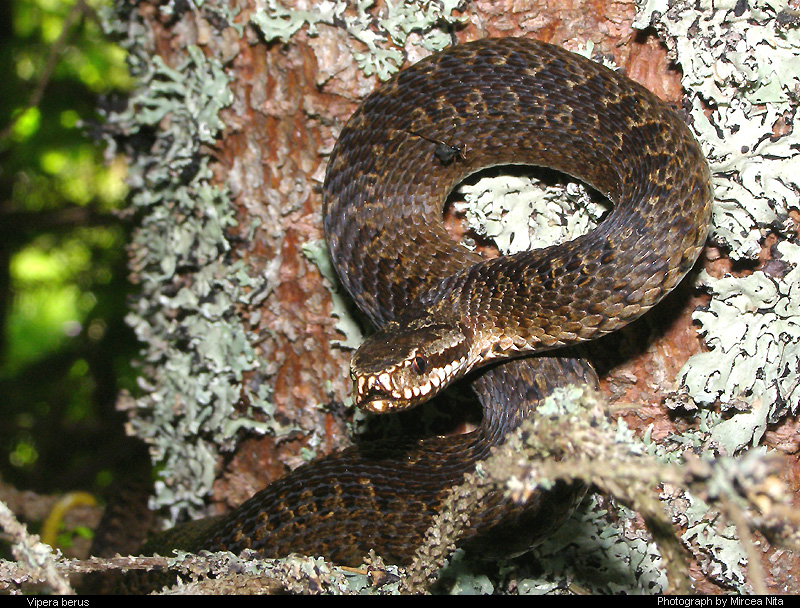
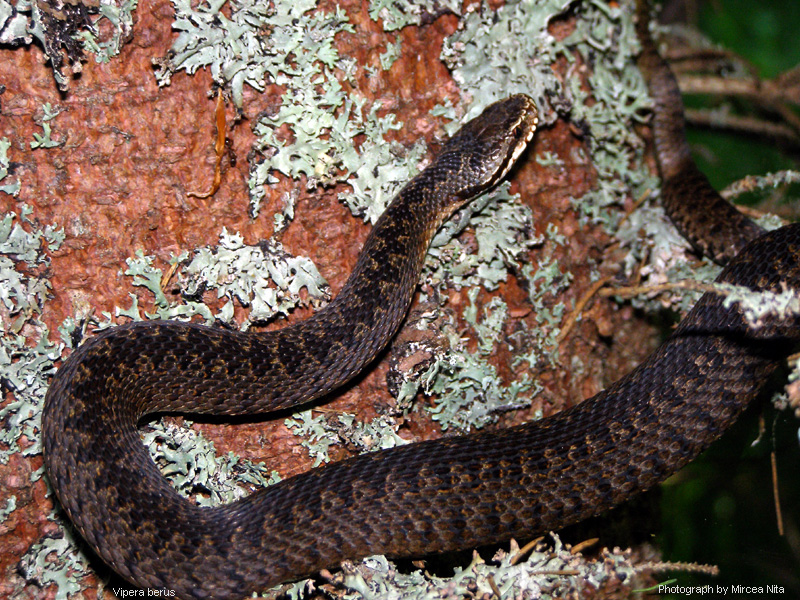
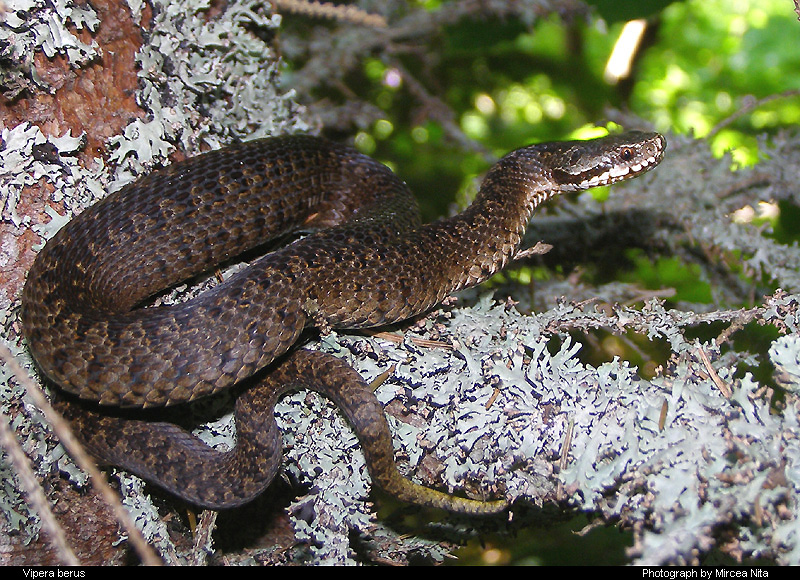
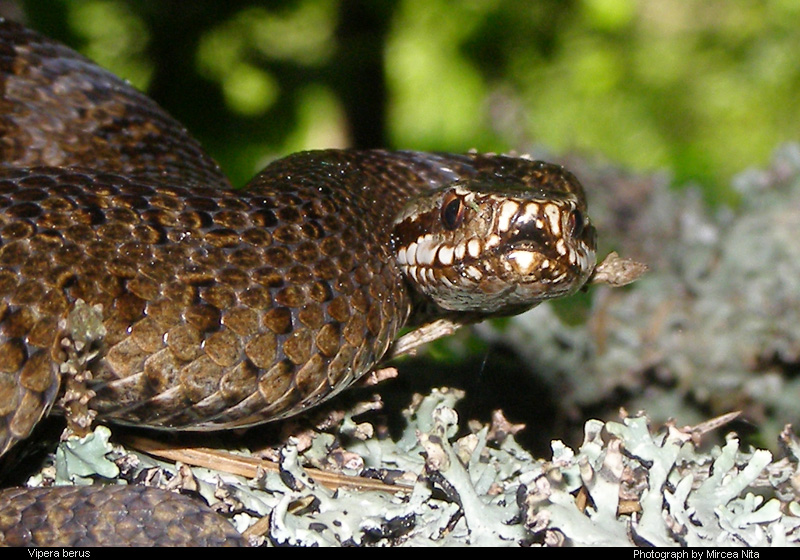
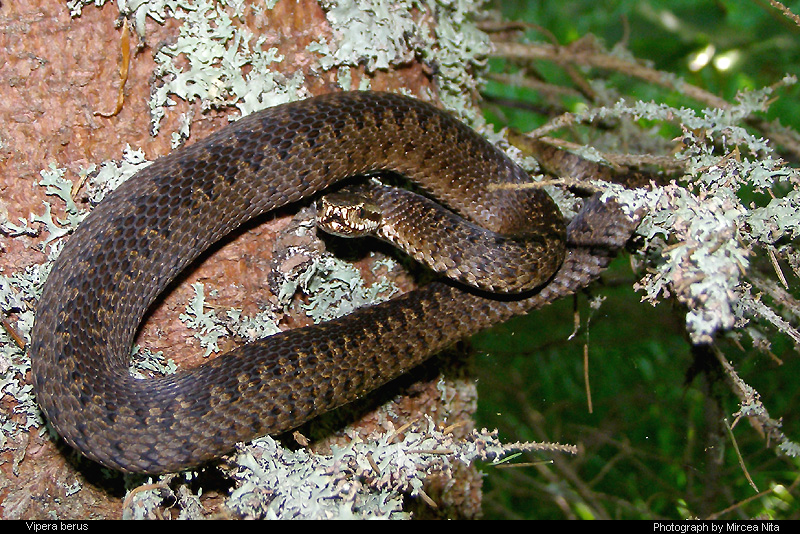
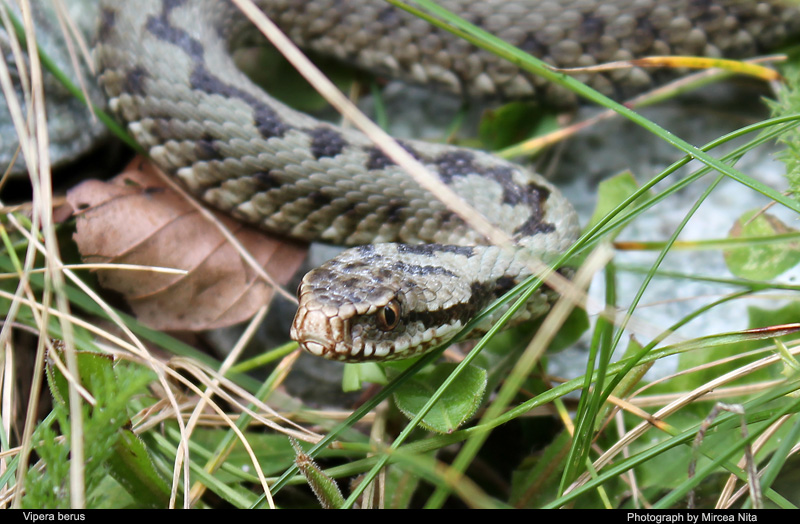
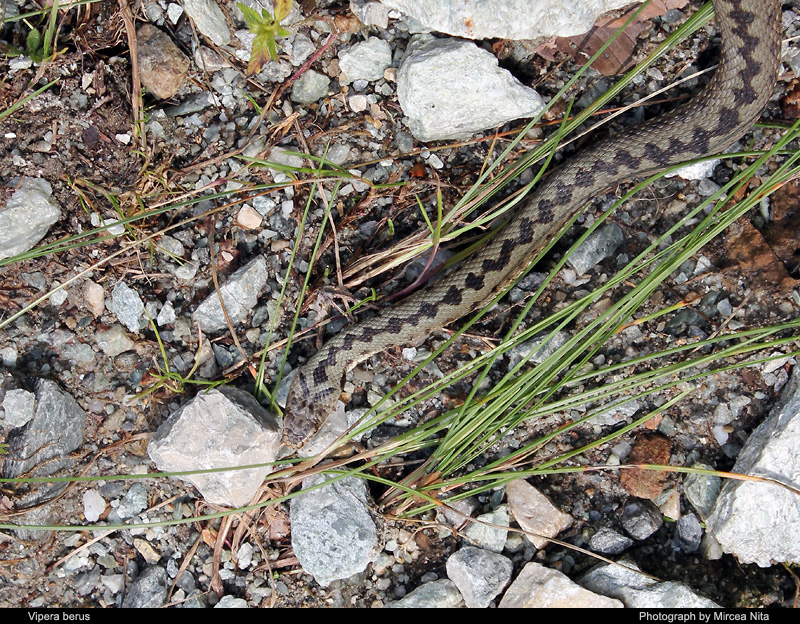
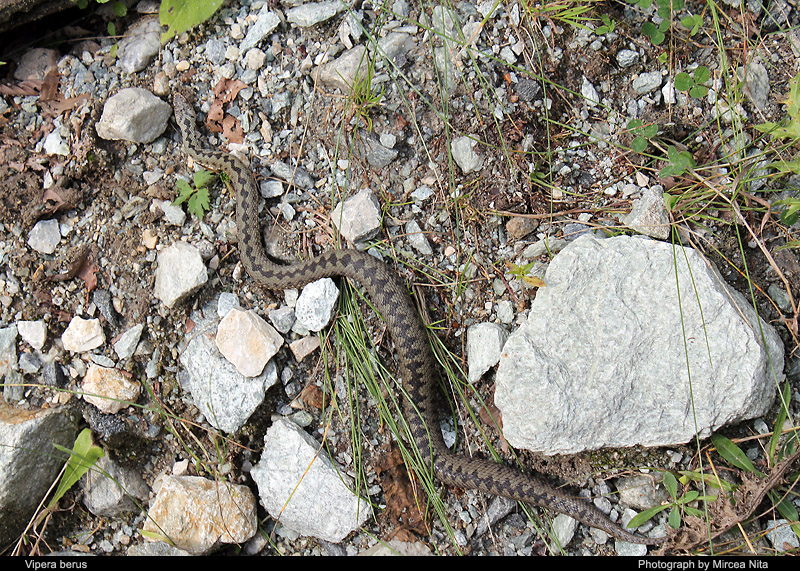
Vipera berus
Common adder - Vipera berus, LINNAEUS, 1758
Vipera berus is a venomous snake that is extremely widespread and can be found throughout most of Western Europe and all the way to Far East Asia in Sakhalin Island.
Description:
Common adders usually grow to a length of 50 to 90 centimetres and females of the species may achieve a larger size than the males. Their body is short and stout. Head distinct from neck, covered with small shields or scales. The eye is relatively large - equal in size or slightly larger than the nasal scale - but often smaller in females. Snout truncate or broadly rounded, flat above or with slightly raised canthus. Rostral in contact with two apical shields, rarely with one. Rostral as deep as broad or slightly broader than deep, rarely once and one-third as deep as broad, not or but scarcely visible from above; 6 to 10 supralabials, usually 8 or 9; large frontal and parietals; frontal separated from supraocular by 1 to 4 shields. 6 to 13 scales round the eye, usually 8 to 10; 2 or 3 superposed scales, rarely 2 vertical series of scales, separate the preoculars from the nasal, which is single. There is a single series of scales between the eye and the labials; specimens with two series are very rare. Three or four (rarely five) lower labials in contact with the single pair of chin-shields.
There are 21 dorsal scales rows (rarely 19 or 23). The scales are strongly keeled except for the outer row which is smooth or feebly keeled. Males have 132 to 150 (usually 137 to 147) ventral shields, females 132 to 158 (usually 140 to 150); subcaudals 32 to 46 (usually 35 to 40) in males, 24 to 38 (usually 28 to 33) in females; the anal is single.
This species present such marked differences of colour, according to the sexes, that these can be distinguished in most cases from that character alone.
Male adders tend to be whitish or pale grey with a black ventral zig-zag marking. Females are usually brownish or brick-red with a dark brown zig-zag pattern. The basal colour of males will often be a tad lighter than that of the females, making the black zigzag pattern stand out. However, the adder can demonstrate a tremendous diversity in colouration. There are also brown, reddish-brown or olive males with the markings of a deep black, and grey males with brown markings. Another colour variety, which affects only females, is olive with brick-red band and spots. Females have yellowish-white chin and throat, which may be tinged with red; males have the throat black, or whitish with the scales spotted or edged with black.
The markings may vary considerably. Those on the back usually consist of a wavy or zigzag longitudinal band, flanked on each side with a series of spots corresponding to its sinuses; this band may be partly or even entirely broken up into rhomboidal or transversaly oval spots, or, losing its indentations, form a straight stripe edged on each side with a yellowish streak.
The head usually has a pair of elongate dark markings; by uniting together this pair may form a distinctive dark A or X. An oblique dark streak extends on each side from the eye to the last labial shields, being sometimes prolonged a short way down the neck. The labial shields are whitish or yellowish, those at least which are anterior to the eye being more or less broadly edged with brown or black.
The ventral colour and the lower surface of the tail may vary from grey or brown to bluish, blackish-grey, or black, the sides usually dotted or spotted with whitish; sometimes, especially in females, the belly is dark grey, each shield with a white posterior border which is broken up by a series of small roundish black spots.
The end of the tail is often yellowish, bright yellow or pale orange below, rarely coral red, more commonly in females than in males. The iris is usually coppery red. Black specimens occur, more or less frequently, all over the habitat of this species.
Biology:
Common adder is a diurnal predator (especially in the north of its range) however on warm summer nights it is known that adders also hunt during the hours of darkness.
Vipera berus is predominantly a terrestrial species, but often climb up banks and into low bushes or trees in order to bask or search for prey.
Usually the common adder is an ambush predator but they can often be seen actively hunting for prey.
Its food is very varied: mice, weasels, voles, shrews, moles, birds (especially nestlings and even eggs), lizards, slow-worms, frogs, salamanders and even large slugs, and the very young feed also on insects and worms.
The mating period varies, depending upon annual weather conditions, but usually pairing takes place in April and May, and the young, five to twenty in number, are born in the end of July, August or September; the young, on releasing themselves from the thin, transparent membrane in which they are enclosed at birth, measure 14 to 23 cm and are born with a fully functional venom apparatus. Within a day or two they will shed their skins for the first time.
The young snakes are left to fend for themselves, but can often be seen basking in twos or threes for the first month of life.
Exceptionally, some individuals pair late in the summer or in the autumn but it is not known if the autumn matings result in any young.
Males emerge from hibernation in the spring about a month before the females and are extremely territorial during mating season, often sparring with each other to defend territories.
After mating, the male will then remains for one or two days next to the female in an attempt to prevent other males from mating with her. If a rival male approach both males will wind around each other, trying to push each other to the ground, producing a real spectacle known as the "dance of adders". The "dance" lasts only for a few minutes before one of the two becomes exhausted and leave the site.
Common adders have a slow reproduction rate, only reproducing every two or even three years if the seasons are short and the climate is severe. The energy used to produce the young cannot be replaced in a single year, so adders are (generally) not capable of giving birth every year.
The species is well adapted to cool weather and hibernates in the cold season for about 5 to 6 months in southern range; in northern range hibernation lasts 8-9 months.
Hibernation sites must be dry, and have protection from frost and predators. Living root systems and especially the root systems of trees that have been blown over by gales and have overgrown will be ideal hibernation sites.
These are of vital importance for the survival of the species because adders often use the same place to hibernate for years.
Not known to be aggressive the adders tend to be rather timid and strike especially if disturbed or caught off guard, particularly while basking in the sun. The adder's first defence against all predator threats is to move quickly and silently into the undergrowth. When threatened will posture (head raised, body coiled to strike) and hiss loudly to warn off potential aggressors and only as a last resort the Adder will bite.
Natural predators include badgers, foxes, pine marten and even hedgehogs. Also birds of prey will take an adder, some sea gulls and even herons.
The venom toxicity of the Adders has been described (Mallow et al. - 2003) as being relatively low compared to other viper species. Statistics show most recorded snake bites in human victims are reported from campers, hikers and farm workers. Human envenomation from the common adder tends to be about 100 individuals each year, averaging a dozen deaths but some of these fatalities actually result from a severe adverse reaction to the antivenom treatment and not the snake bite itself. Antivenom is only used for severe bites, although anybody bitten by an adder should seek immediate medical attention.
Habitat:
Adders can be very adaptable, being found predominantly on dry heathland, chalk grassland, rocky hillsides, sandy heaths, meadows, woodland margins, sunny glades and clearings, hedgerows, bushy slopes.
All these habitats must provide a good food source of small mammals, good cover to offer some protection from predators and human harassment and and open sunlight spots for thermal regulation.
Distribution:
Well adapted to cool conditions the Adder is the most northerly distributed reptile.
They can even be found within the edge of the arctic circle.
This species ranges southwards from Scandinavia and the Baltic region to France and the United Kingdom (excluding Ireland), and eastwards through Europe (excluding peninsular Italy and most of Greece) to Russia (as far east as Sakhalin Island), Mongolia, the People's Democratic Republic of Korea and northwestern China. On the Balkan peninsula it is restricted to mountaine areas and has a very fragmented distribution. It has been recorded from sea-level up to 2700m altitude (in the Alps and in Bulgaria).
Scientific name: Vipera berus
Common name: Common adder
Taxonomy:
This species has been intensively studied by many researchers and are accepted three subspecies of the common viper: Vipera berus berus (Linnaeus, 1758), Vipera berus bosniensis (Boettger, 1881) and Vipera berus sachalinensis (Tsarevsky, 1917).
In addition to these three subspecies, the taxonomic status of other three taxa is still debated, and opinions differ from one author to another: Vipera seaoeni (Latastei, 1879), Vipera barani (Bohme & Joger, 1983) ?i Vipera nikolskii (Vadmeria, Grubant et Rudayeva, 1986).
The subspecies V. b. bosniensis and V. b. sachalinensis have been regarded as full species in some recent publications.
The taxonomic status of these forms up to now remains the subject of continuous discussions.
IUCN Status: LC (Least Concern)
This species is listed as Least Concern in view of its wide distribution, presumed large population and broad range of habitats.
Under the Berne Convention this species is listed as protected (Appendix III). It occurs in many protected areas throughout its range. It is protected by national legislation in parts of its range. This species is categorized as Endangered in Switzerland.
Unfortunately, Adders are still persecuted by humans, with many being killed each year from fear or ignorance. The main threat to the adder is loss of habitat due to the intensification of agricultural methods and development so, in Europe, populations of this species have been significantly fragmented.
References:
Arnold, E. N., and J. A. Burton. 1978: A Field Guide to the Reptiles and Amphibians of Britain and Europe. Collins, London;
Boulenger, G.A., 1913: The Snakes of Europe;
Fuhn, I. & S. Vancea, 1961: Fauna Republicii Române, 14. Reptilia (Testoase, Sopârle, Serpi). Bucuresti;
Gasc, J.-P., A. Cabela, J. Crnobrnja-Isailovic, D. Dolmen, K. Grossenbacher, P. Haffner, J. Lescure, H. Martens, J.P. Martinez-Rica, H. Maurin, M.E. Oliveira, T.S. Sofianidou, M. Veith & A. Zuiderwijk, 1997: Atlas of Amphibians and Reptiles in Europe. - Societas Europaea Herpetologica und Muséum National d'Historie Naturelle (IEGB/SPN), Paris;
IUCN 2011. IUCN Red List of Threatened Species. Version 2011.2. ;
Joger, U. & N. Stümpel, 2005: Handbuch der Reptilien und Amphibien Europas, Wiebelsheim;
Mallow, D. Ludwig, D. & Nilson, G., 2003: True Vipers: Natural History and Toxinology of Old World Vipers. Krieger, Malabar, Florida.
|
|
|

